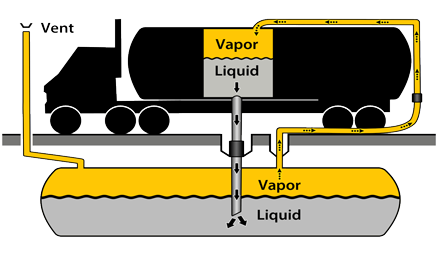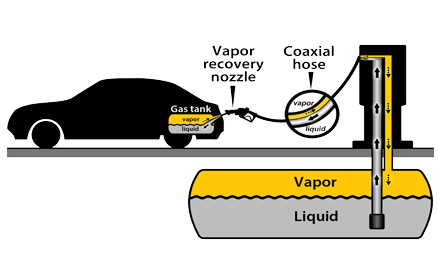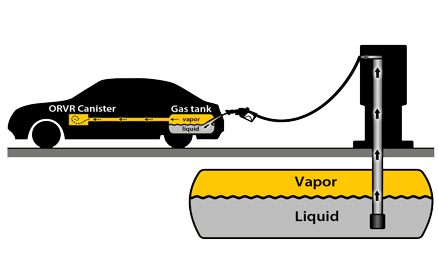Gasoline Dispensing Facilities
Stage I - Vapor Recovery

What is Stage I?
Stage I Vapor Control is the control of gasoline vapor emissions that occurs when gasoline is delivered in bulk from tanker trucks to the storage tanks located at GDFs. Stage I Vapor Recovery is the system used to capture the vapors displaced from the storage tanks during these deliveries. The captured vapors are piped back into the empty space within the tanker truck so they can be returned to the terminal for processing.Stage I requirements apply to the owner or operator of underground and aboveground gasoline storage tanks.
Applicability is based on a GDF's monthly gasoline throughput, which is calculated by adding the quantity of gasoline dispensed in any consecutive 365-day period and dividing by 12.
- GDFs with a monthly gasoline throughput of more than 10,000 gallons since 7/1/2014 are subject to the new Stage I requirements.
- GDFs with a monthly gasoline throughput of less than 10,000 gallons per month are required to keep a chronological register of daily gasoline throughput to demonstrate that the requirements of this section do not apply. Such records shall be kept for 5 years from the date of creation.
For GDFs with a monthly throughput of 100,000 gallons or more per month:
- Equip all vapor line connections on storage tanks with closures that seal upon disconnect.
- Stage I system shall be designed such that the pressure in the delivery vehicle does not exceed 18 inches water pressure or 5.9 inches water vacuum during product transfer.
- Vapor recovery adaptors, product adaptors and the method of connection with the delivery elbow shall be designed to prevent overtightening or loosening of fittings during normal delivery operations.
- Gauge wells shall be equipped with a submerged drop tube extending the same distance from the bottom of the storage tank as the fill pipe, if separate from the fill tube.
- Equip liquid fill connections and vapor couplings with vapor-tight caps.
- Stage I system must be capable of meeting the static pressure performance requirement when pressure decay testing is performed.
Equipment Requirements
- GDFs must have California Air Resource Board (CARB) approved swivel fill adapters, and each storage tank vent pipe must have a pressure/vacuum (P/V) vent valve. P/V vent valves installed after 7/1/2015 must be CARB approved.
- Equip all storage tanks with a two-point Stage I vapor recovery system in which the exit port is designed and maintained to seal when the vapor return line is disconnected in order to prevent the discharge of gasoline vapors. If a port is not available to install a two-point system, one must be installed when the tank is replaced or the product in the tank is switched from any other fuel to gasoline.
Annual Testing
Conduct pressure decay, vapor space tie-in, and P/V vent valve tests at least once per calendar year in accordance with the following:
- Pressure decay, vapor space tie-in, and P/V vent valve tests must be done according to the current version of respective CARB approved Test Procedures, TP-201.3, TP-201.3C, and TP-201.1E.
- Pressure, vacuum, and leak rate tests must be conducted for each P/V vent valve. The positive cracking pressure range has been widened to 2.5 to 6.0 inches of water, the negative cracking pressure range is 6.0 to 10.0 inches of water. Combined total leak rate of all P/V vent valves, including connections, shall not exceed 0.17 cubic foot/hour at a pressure of 2.0 inches of water and 0.63 cubic foot/hour at a vacuum of 4.0 inches of water.
- GDFs newly constructed or modified after 7/1/2015 must conduct the tests listed above within 60 days of initial operation or completion of modification.
- If you have installed a pressure management or vapor control device on a storage tank with a capacity of 250 gallons or greater, other than a device that is required to be installed and tested by this section, test such device annually. Submit a test protocol for approval at least 60 days prior to such test. Pressure Management/Vapor Control System Test Protocol Form, FAQ
- If a GDF fails a pressure decay, vapor space tie-in or P/V vent cap test, take corrective actions and retest no later than 60 days after failing the test.
A partial list of Stage I testing companies is provided for your convenience. This list was created from Department records of testing companies that have properly notified the Department and conducted Stage I vapor recovery tests in Connecticut over the last several years. Providing the list does not constitute an endorsement or recommendation by the State of Connecticut, the Department of Energy and Environmental Protection (DEEP), or any other entity of any individual or testing company.
Notification Requirements
- Notify DEEP in writing of the time and location of a required test at least 7 business days in advance.
Submit a Pressure Decay Test Notification () to air.vapor.program@ct.gov with the following in the subject line:
"Pressure Decay Test Notification, Station Name, Street Address, Town, and Retail Gasoline Dealer's License #"
- Submit a completed Stage I Vapor Recovery Test Results Report, no later than 10 days after testing, to air.vapor.program@ct.gov with the following in the subject line:
"Stage I Test Results, Station Name, Street Address, Town, and Retail Gasoline Dealer's License #"
Recordkeeping Requirements
- Maintain the following records: licenses to construct/operate the GDF, results of tests performed pursuant to RCSA Section 22a-174-30(a), records of maintenance and repairs conducted on the Stage I system, and a chronological file of all inspection reports, compliance records and a register of daily throughput.
- Maintain records for 5 years and make available to the Commissioner no later than 3 business days after receiving such a request.
- Display the address where records are maintained in a conspicuous location.
Please Note - Stage I requirements do not address any requirements you may have or be subject to for the DEEP Underground Storage Tank (UST) Program. If you have any questions relating to those requirements, please contact the UST Program at (860) 424-3374.
Stage II - Vapor Recovery

What is Stage II?
Stage II Vapor Recovery is an obsolete system used, prior to July 2015, to control gasoline vapor emissions that occurred when vehicles were being fueled at GDFs. Stage II Vapor Recovery captured the gasoline vapors at the vehicle fill pipe. The captured vapors were returned to the empty space in the storage tank at the GDF. The vapors stored in the storage tanks were later transferred to the terminal for processing during the next bulk delivery via the Stage I Vapor Recovery system.
Federal regulations have required the installation of ORVR systems in all vehicles since 1998. In the early 2000's, EPA determined that Stage II and ORVR systems were incompatible with each other and actually caused an increase in emissions. In order to evaluate the effectiveness Connecticut's GDF Vapor Control Program, DEEP commissioned an Analysis of Future Options for Connecticut's Gasoline Dispensing Facility Vapor Control Program .
As a result of the analysis and to resolve the incompatibility of Stage II and ORVR systems, Public Act No. 13-120: An Act Concerning Gasoline Vapor Recovery Systems (Fact Sheet) was adopted on June 18, 2013, which required GDFs in Connecticut to decommission all Stage II vapor recovery systems.
On June 18, 2013, Public Act No. 13-120 (Fact Sheet) was signed into law and immediately became effective. This Act repealed the previous version of Connecticut General Statute Section 22a-174e, which required DEEP to adopt regulations pertaining to the installation and testing of Stage II vapor recovery systems and replaced it with language that mandates the decommissioning of all Stage II systems by July 1, 2015.
Any GDF with a Stage II system currently in place is in violation of Public Act No. 13-120. The owner/operator of the GDF must notify DEEP and decommission their Stage II equipment immediately.
In order to complete the decommissioning process, the forms listed below must be completed and submitted to air.vapor.program@ct.gov with the following in the subject line:
- Intent to Decommission Notification |
"Intent to Decommission Notification, Station Name, Street Address, Town, Fuel Brand, and Retail Gasoline Dealer's License #"
- Pressure Decay Test Notification |
"Pressure Decay Test Notification, Station Name, Street Address, Town, Fuel Brand, and Retail Gasoline Dealer's License #"
- Certification Report for a Decommissioned Stage II Vapor Recovery System |
"Certification for Decommissioned Stage II Vapor Recovery, Station Name, Street Address, Town, Fuel Brand, and Retail Gasoline Dealer's License #"
Onboard Refueling Vapor Recovery

What is ORVR?
Onboard Refueling Vapor Recovery (ORVR) captures fuel vapors from the vehicle gas tank during refueling. In vehicles with ORVR, the gas tank and fill pipe are designed so that when refueling the vehicle, fuel vapors in the gas tank travel to an activated carbon packed canister, which adsorbs the vapor. When the engine is in operation, it draws the gasoline vapors into the engine intake manifold to be used as fuel.
Widespread Use of ORVR
New passenger cars, light-duty trucks, and most heavy-duty gasoline powered vehicles are now equipped with ORVR systems. ORVR systems are more effective at capturing gasoline vapors and less expensive than Stage II vapor recovery systems. The phase-in of ORVR controls has eliminated the need for Stage II vapor recovery systems and the interaction between the two types of incompatible systems may actually increase vapor emissions.
Image Source
Potter, Z., Thomas, E., Whitener, V., & Konopaski, K. (2015). Gas Vapor Regulations: The Legislature's Decentralized Approach Neither Requires nor Produces Consistency, and Current Regulations May Be Requiring Outdated Technology (Final Report 14-4). Retrieved from Washington State Joint Legislative Audit and Review Committee (JLARC) Audit and Study Reports Webpage.
Questions
Please contact Kathleen Rankin at kathleen.rankin@ct.gov or (860) 424-3473 if you have questions or need any additional information.
Compliance Assurance Home | Training & Education | Forms | Enforcement | Other Programs | FAQs | Contact Us
Content Last Updated: September 9, 2025

